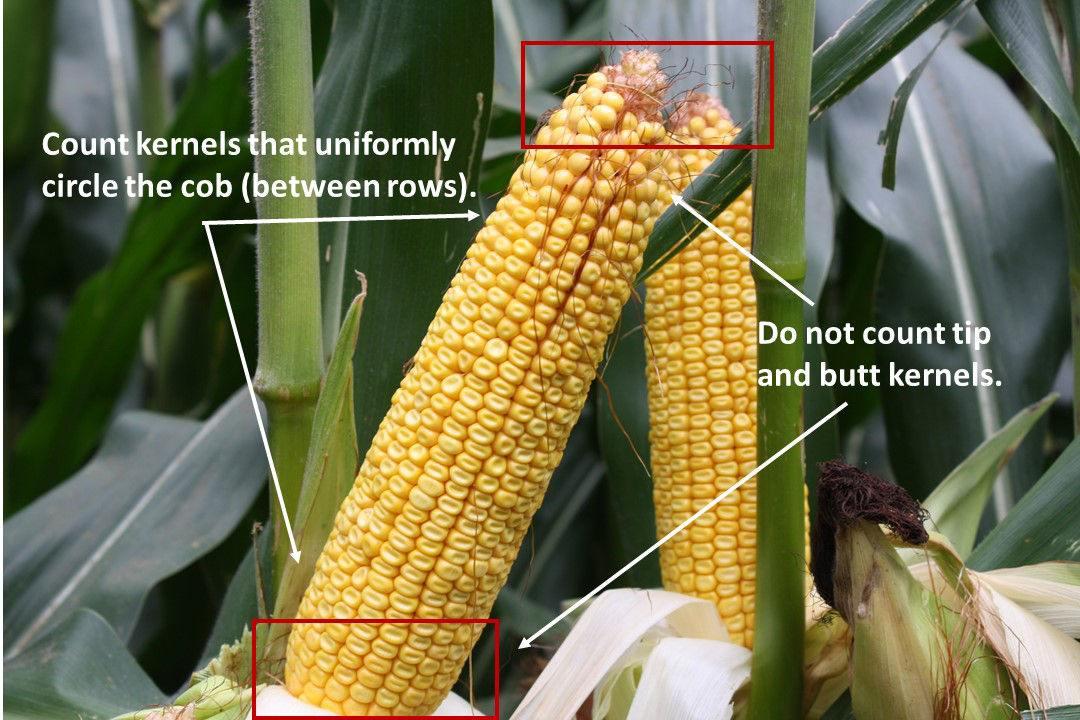5 MIN READ
Assessing Corn Yield Potential
August 30, 2021
Estimating corn yield potential can be helpful with harvest planning and different methods can be used to estimate yield potential at separate times during the growing season. Crop uniformity has a large influence on the accuracy of any estimation method. Samples should be taken randomly throughout a field to provide the best yield estimate. One sample for every 10 to 15 acres should be enough unless conditions are variable. More samples should be taken in a nonuniform field to improve the accuracy of the estimate.
The corn yield component method and the corn ear weight method are two ways to estimate corn yield potential prior to harvest. Each method can produce yield estimates that are within 20 bu/acre of actual yield.1
Corn Yield Component Method
This widely-used method can be used as early as the milk growth stage (R3).2 Estimating the yield prior to R3 is risky because stresses can affect kernel development and cause kernel abortion.3 This method is based on the assumption that grain yield can be estimated using the number of ears per acre, number of kernel rows per ear, number of kernels per row, and kernel weight. The first three components can be measured from field samples, but kernel weight is unknown until physiological maturity (black layer) and must be represented by a calculated factor. The average value for kernel weight (90) is derived using 85,000 kernels per 56-pound bushel (Table 1).4 Some agronomists think that a kernel weight of 80 to 85 is a more appropriate factor for current use because kernel size has increased since this formula was first developed many years ago.3
Step 1. At each sample site, measure 1/1000th of an acre (Table 2). Do not sample abnormal ears, nubbins, or aborted kernels, and avoid dropped ears or ears on severely-lodged plants. Count kernels where there are complete rings of kernels around the cob, and avoid counting kernels on the extreme ends of the ear (Figure 1).1
Step 2. Count the number of kernel rows per ear on every fifth ear and determine the average.
Step 3. On the same fifth ears, count the number kernels per row and determine the average.
Step 4. Determine an estimate of yield potential per acre at each sample site by multiplying the number of ears by the average number of rows and the average number of kernels and dividing by 90 or the factor that best represents growing conditions (Table 1).
Yield (bu/acre) = (ear #) × (average row #) × (average kernel #)/90
Step 5. Repeat this procedure at a representative number of sample sites in the field. Calculate the average yield potential of all the sites to get an estimate of the yield potential of the entire field.

Example: Harvestable ear count is 30. The average number of kernels per ear from every fifth ear is 511. Growing conditions were average (85). The estimated yield potential for that site would be 30 multiplied by 511 and divided by 85, or a 180 bu/acre estimate of yield potential.
Poor conditions during grain fill can cause lower kernel weights, resulting in an underestimation of yield potential with the yield component method. Conversely, it can overestimate yield potential if kernel weight is higher than normal, during superior growing conditions.3 Kernel size and weight can vary by corn product and environmental conditions, which can compromise the accuracy of the estimate.
Corn Ear Weight Method
This method should only be used after corn has reached physiological maturity or black layer (R6). This method may be more accurate than the corn yield component method because it is based on actual kernel weight. However, it does account for average shell out percentage.3
Step 1. Sample several representative sites in a field. Count the number of harvestable ears in 1/1000th of an acre at each site (Table 2) at several random sites throughout the field. At each site:
a. Weigh every fifth ear and calculate the average ear weight per site.
b. Hand shell kernels from those ears.
c. Determine the average grain moisture with a moisture tester.

Step 2. Calculate the average yield potential at each site:
a. Multiply the number of ears by the average ear weight.
b. Multiply average grain moisture by the factor 1.411.
c. Add 46.2 to (b).
d. Divide result from (a) by the result from (c).
e. Multiply the result from (d) by 1,000.
Example: The number of harvestable ears is 24. Average ear weight of every fifth ear is 0.5 lb. The average grain moisture is 30%.
The estimated yield potential is [(24 × 0.5)/ (1.411 × 30) + 46.2)] x 1,000 = 135 bu/acre.2,5
There are several other methods to estimate corn yield potential that are less widely used than the yield component and ear weight methods.2
Sources:
1Nafziger, E. D. 2002. Illinois agronomy handbook, 24th edition. Chapter 2. University of Illinois Printing Services. Urbana, IL. 23-25. http://extension.cropsciences.illinois.edu/.
2Lauer, J. L. 2002. Methods for calculating corn yield. Agronomy Advice. Corn Agronomy. University of Wisconsin. http://corn.agronomy.wisc.edu/.
3Thomison, P. 2015. Estimating corn yields. C. O. R. N. Newsletter. Agronomic Crops Network. Ohio State University Extension. https://agcrops.osu.edu/.
4Nielsen, R. L. 2018. Effects of stress during grain filling in corn. Corny News Network, Purdue University. https://www.agry.purdue.edu/.
5Birkey, N. 2009. Estimating grain yields in corn. Michigan State University Extension. https://www.canr.msu.edu/news/.
Web sites verified 6/24/2020
6014_S4
